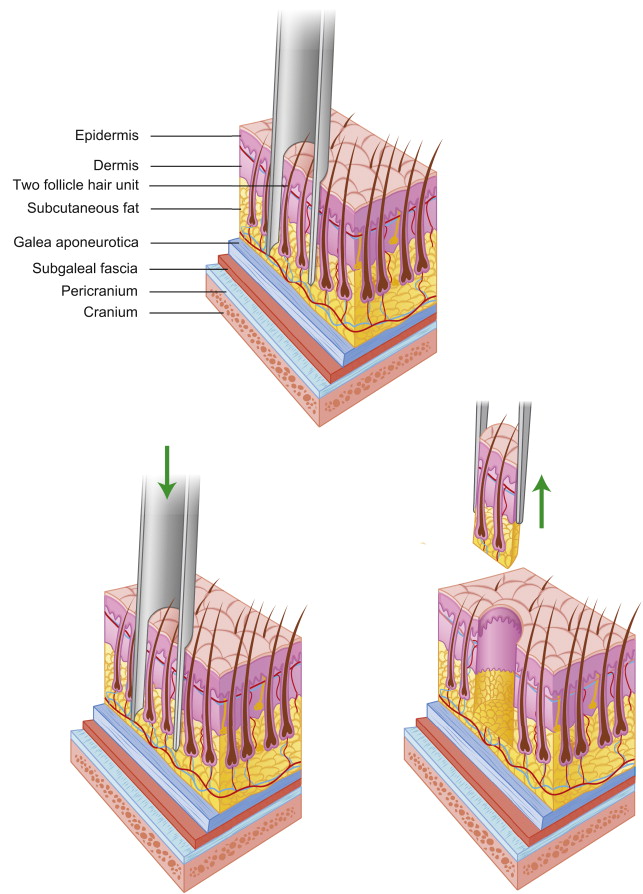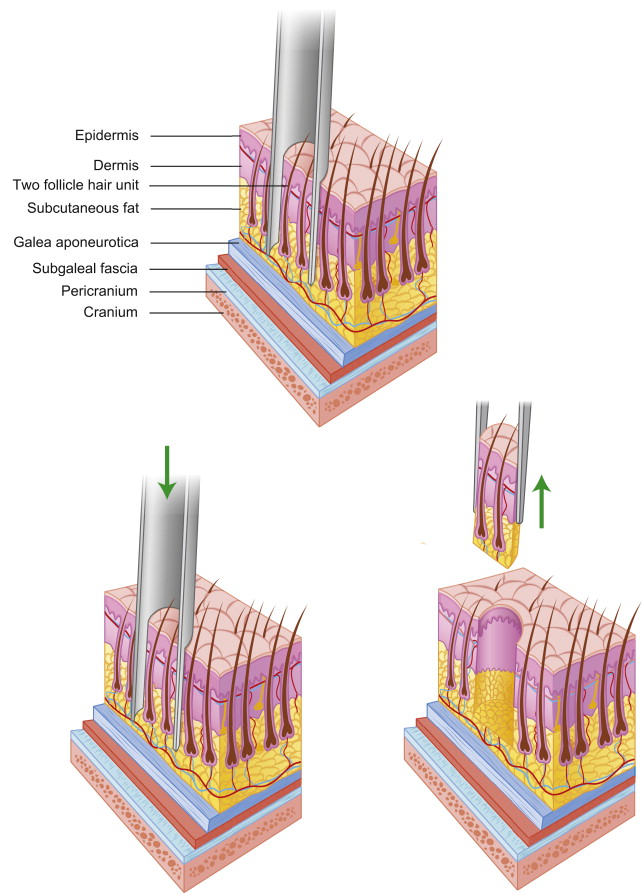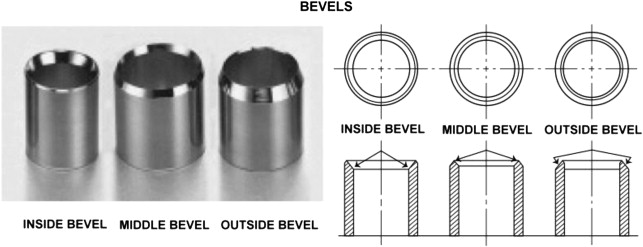Success in follicular unit extraction requires an understanding of forces, fluid dynamics, instrumentation, and individual patient variation. Sharp punches require a lower axial and tangential force to dissect follicular groups. The angle of hair emergence and the size of a punch influence the wound size and the depth of an incision. A procedure must be individualized based on surface follicular group characteristics; hair splay; and strength of attachment between the outer root sheath, inner root sheath, and adipose with regard to hair follicles.
Key points
- •
Follicular unit extraction punches are made from a variety of metals.
- •
The degree of sharpness varies significantly from one punch manufacturer to another.
- •
Sharp punches require less axial and tangential force to penetrate the skin and dissect hair follicles.
- •
Minimizing axial and tangential forces helps to reduce the fluid movement of hair follicles during the dissection process.
- •
Force compression testing allows the degree of sharpness of any punch to be determined.
- •
Follicular groups consist of between 1 and 6 hair clusters. The frequency of cluster size varies from one person to another.
- •
The degree of hair splay varies from one person to another.
- •
Variation in punch size and incision depth allows the dissection of grafts to be customized to the individual patient and follicle transection to be minimized.
Introduction
Follicular unit extraction (FUE) is the latest major technical advancement in surgical hair restoration. The methodology of FUE evolved from the basic principles of circular graft extraction that were introduced more than a half century ago. However, unlike macroscopic plug hair restoration, which used large circular punches, FUE is a refined procedure that requires high-power magnification and uses small circular trephine punches to isolate and extract individual follicular units ( Fig. 1 ). The driving force for developing this technique was elimination of the linear donor scar that accompanies traditional strip harvesting. Shorter hair styles and a greater awareness for cosmesis in the donor site stimulated this movement.

The follicular unit is a delicate structure that is vulnerable to several types of injury during the extraction process. Transection is perhaps the most common injury observed with FUE ( Fig. 2 ). Success with FUE depends on being able to predictably dissect excellent-quality grafts from the donor region. A high-quality trephine punch is mandatory for the accurate isolation of individual follicular units. The hair restoration surgeon must have a thorough understanding of the FUE punch and the nuances of FUE surgical technique to ensure consistent graft quality.

Introduction
Follicular unit extraction (FUE) is the latest major technical advancement in surgical hair restoration. The methodology of FUE evolved from the basic principles of circular graft extraction that were introduced more than a half century ago. However, unlike macroscopic plug hair restoration, which used large circular punches, FUE is a refined procedure that requires high-power magnification and uses small circular trephine punches to isolate and extract individual follicular units ( Fig. 1 ). The driving force for developing this technique was elimination of the linear donor scar that accompanies traditional strip harvesting. Shorter hair styles and a greater awareness for cosmesis in the donor site stimulated this movement.

The follicular unit is a delicate structure that is vulnerable to several types of injury during the extraction process. Transection is perhaps the most common injury observed with FUE ( Fig. 2 ). Success with FUE depends on being able to predictably dissect excellent-quality grafts from the donor region. A high-quality trephine punch is mandatory for the accurate isolation of individual follicular units. The hair restoration surgeon must have a thorough understanding of the FUE punch and the nuances of FUE surgical technique to ensure consistent graft quality.

Punch metallurgy
Surgical instruments are made of a variety of types of stainless steel. The type of steel depends on the function of the surgical instrument. FUE is a minimally invasive procedure dependent on a strong material with a sharp edge, thin wall, and small volume. Modern FUE punches are made of a variety of elements including Fe, C, Cr, Ni, Mn, Mo, Si, P, and S. Chromium makes stainless steel corrosion resistant. The other elements enhance other properties of the steel. Some materials, like 303 and 304 stainless steel, cannot be hardened by heat treatment. Other materials, like 17-4, 420, and 465, can be heat treated to harden them to a higher level. Hardness is a measure of the resistance to deformation or indentation. The hardness of steel is often measured using the Rockwell scale, which is a measure of indentation depth under load or indentation hardness.
Punch handle and trephine
Many physical and technical factors affect punch cutting dynamics and their related tendency to produce tissue distortion and graft damage:
- •
Punch diameter
- •
Cutting edge location
- •
Punch wall thickness
- •
Punch metal type
- •
Punch edge sharpness
- •
Punch edge shape (smooth vs contoured)
There are 3 important diameters with respect to an FUE punch:
- 1.
Internal diameter (distance between the internal margins of the punch)
- 2.
External diameter (distance between the outer margins of the punch)
- 3.
Cutting diameter (distance between the cutting edges of the punch) ( Fig. 3 )

Fig. 3
Punch cutting edge styles.
The cutting edge is located in one of 3 important locations and the bevel is situated according to each:
- 1.
Inside margin cutting edge with an outside bevel (type 5 punch)
- 2.
Middle margin cutting edge with a middle bevel (type 4 punch)
- 3.
Outside margin cutting edge with an inside bevel (type 3 punch)
The distance between the cutting edges determines the physical location of the incision on the skin. The location of the cutting edge also affects the fluid dynamics on the tissue during the punching process. An outside diameter (inside bevel) is designed to minimize the effect of the fluid dynamics during the punching process as the blunt bevel abuts tissue that has already been cut. The author has found that this design improves tissue cutting, reduces follicle trauma, and is best for high-quality extractions. The inside diameter (outside bevel) punch cuts a narrow hole in which the blunt outside bevel is forced into a hole that is smaller than the outer diameter of the punch. This punch style seems to have the greatest deleterious impact on follicle fluid dynamics and could increase the risk of a lower-quality graft. The middle diameter or middle bevel punch has the cutting edge somewhere between the external and internal punch margins, and seems to have an intermediate impact on adverse follicle fluid dynamics and graft quality.
Tissue distortion is also influenced by the thickness of the punch wall and by the rate of punch insertion. In all instances, a thin punch wall reduces the resistance as the punch is introduced into the skin.
A titanium nitride (TIN) coating helps to improve the life of the cutting edge on punches made of soft steel. However, these punches lack the degree of sharpness that modified hardened steel punches possess. TIN-coated punches are perhaps the most popular of all the sharp punches and they are the least expensive. The punches range from 0.6 mm up to 1.5 mm in diameter depending on physician preference. The internal diameters of these punches decrease after a few millimeters ( Fig. 4 ). The internal diameters of punches vary, depending on the arbitrary discretion of the manufacturer and the vendor. However, some manufacturers and vendors label their punches with inaccurate internal diameters. Hardened steel punches have a razor sharp edge that minimizes friction as the punch enters the skin and results in a reduced axial force.
There are multiple handles available that can accept a variety of stainless steel punches. A handle designed to precisely limit cutting depth is available to further boost the accuracy of the hardened steel punches.
Stay updated, free articles. Join our Telegram channel

Full access? Get Clinical Tree




